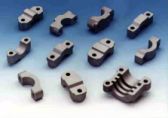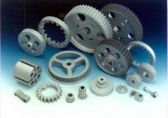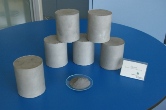


The ongoing demand of the automobile industry in particular to decrease the weight of vehicles by consequent use of light weight materials and construction opens up interesting possibilities for the use of powder metallurgical aluminium parts. On the one hand, near net shape parts with narrow tolerances and difficult geometries can be produced with the traditional processing of powder mixtures (pressing – sintering – calibrating). The high affinity to oxygen and the formation of stable oxide are the challenges for the sintering process of aluminium. With recent successful developments of ready-to-press powder mixtures (e.g. wear resistant aluminium sinter materials with hard particles) as well as new sintering technologies (SLPS-Sintering), a mass production of assemblies has been made possible and first applications could be introduced in engines (camshaft bearing cap (Fig. 1) and camphasing systems). Further interesting applications (Fig. 2) are gears, sprockets, pumps, driving bands for shock absorbers and pistons. It is a high challenge for both powder technology and material science to meet the high demands of powder metallurgical processing and specific component materials’ selection.
On the other side, the high-quality alloying powder can be processed by extrusion to semi-finished PM products with a density of 100 percent for subsequent processing like rolling or forging. High-strength PM materials can be realized via an increase of the alloy contents and the formation of precipitations. An AlZnMgCu-composition, for example, exhibits a high tensile strength of about 750 MPa, high ductility and fracture toughness. Furthermore, homogeneously distributed dispersoids of ceramics or intermetallics improve the heat resistance of PM aluminium. These alloys offer a sufficient stability up to 400 °C. Wear-resistant alloys are characterised especially by their high concentration of silicon. Nowadays, advanced PM aluminium materials for mass production are available and different applications can be found (e.g. cylinder liner).
There is a high potential for improvements of PM aluminium parts as the latest developments concerning material design and process technology have demonstrated (e.g. rapid solidification of metallic melts through Melt Spinning; rapid material compaction by Spark Plasma Sintering); thus, the development from powder to components is far from being finished.
Due to the combination of low density, high melting temperature, high stability and good corrosion resistance, which characterize titanium, many applications of the material in different industry branches can be found already. Initially, the PM technology was used to produce near-net-shape parts in a cost-efficient way. Recent developments of innovative procedures for titanium powder production indicate a clear price decrease in the future. Consequently, this opens up new possibilities for serial production of titanium PM parts.
 Fraunhofer Institute for Manufacturing Technology and Advanced Materials IFAM
Fraunhofer Institute for Manufacturing Technology and Advanced Materials IFAM